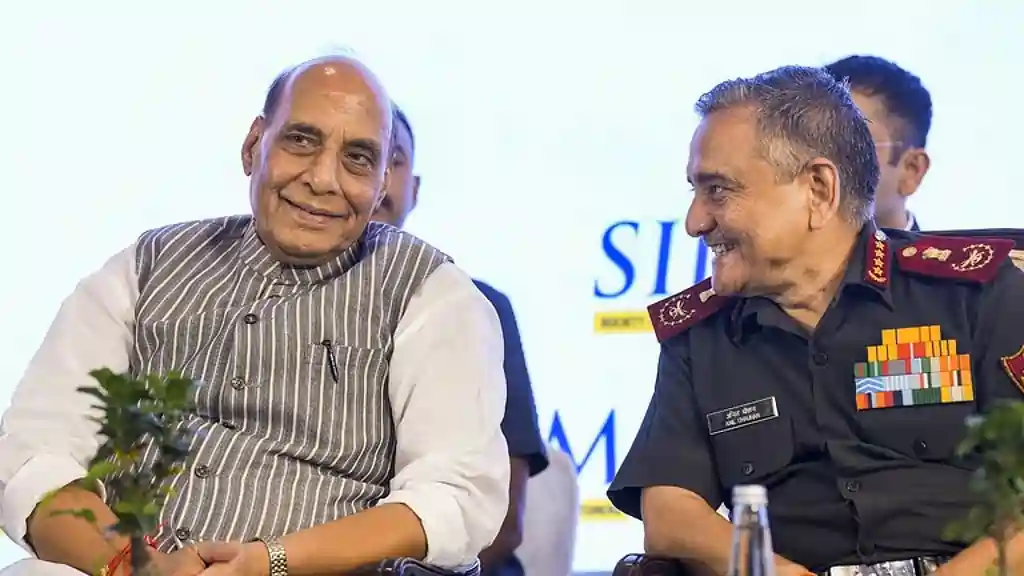New Delhi: In a landmark development for India’s military strategy, the Chief of Defence Staff (CDS) has unveiled three new joint doctrines aimed at bolstering the capabilities of the armed forces. This initiative marks a crucial advancement in promoting jointness, integration, and the path toward theaterisation within the Indian Army, Navy, and Air Force. Released on August 27, 2025, these doctrines address key areas including Special Forces operations, airborne and heliborne activities, and multi-domain operations, setting the stage for more synchronized and effective military responses in an evolving security landscape.

Overview of the Three Joint Doctrines Released by CDS
The release of these doctrines is being hailed as a significant step forward in enhancing interoperability among the services. Here’s a detailed breakdown of each one:
Joint Doctrine for Special Forces (SF) Operations
This doctrine focuses on building a shared foundation for India’s elite commandos across the branches. It aims to foster a common understanding, standardized terminologies, and basic procedures among the Army’s Para-SF, the Navy’s Marine Commandos (MARCOS), and the Indian Air Force’s (IAF) Garuds. Key elements include joint training initiatives designed to minimize duplication and boost efficiency. The document outlines future weapon profiles, operational imperatives, and strategies for command and control across land, maritime, and air domains.
To optimize resources, the doctrine suggests upgrading existing Special Forces Training Schools from the three services into Joint Service Training Institutes (JSTIs). Each institute would serve as a Centre of Excellence for specific core competencies, achieved without altering command structures and by leveraging shared infrastructure, assets, and resources from all services.
Emphasis is placed on specialized training areas such as insertion and extraction operations conducted at night or in adverse weather conditions using night vision devices and conventional methods. It also covers joint training on electronic warfare assets from the three services and skills for terminal guidance of precision-guided munitions launched from air platforms, long-range artillery, or naval gun fire support (NGFS).
In terms of employment, Special Forces provide critical support to field formations under regional commands. For joint operations, they can be deployed through the Headquarters Integrated Defence Staff (IDS) or envisaged integrated structures. The doctrine stresses the need for high interoperability through common standard operating procedures, joint training, and unified communication systems. It highlights the importance of joint training for Para (SF), MARCOS, and IAF SF Garud to maintain adaptable and capable forces against complex security challenges.
CDS General Anil Chauhan, in his foreword, describes this doctrine as articulating a unified philosophy that includes principles, capabilities, and employment strategies for Special Forces in land, maritime, and air domains. It serves as a foundational reference for joint planning, execution, and capacity building aligned with 21st-century roles and missions.
Looking ahead, the doctrine anticipates transformative changes in Special Operations due to revolutionary technologies and innovative applications in the coming decade. Advancements in weapon systems, emerging technologies, and new employment methods are expected to revolutionize the battlefield.
Joint Doctrine for Airborne (AB) and Heliborne (HB) Operations
This doctrine is crafted to ensure seamless coordination between the Army, Navy, and Air Force in airborne and heliborne missions. It addresses doctrinal gaps by standardizing planning and execution procedures, while integrating advanced air mobility assets and unmanned systems for enhanced operational synergy.
The success of such operations in current and future battlefields, according to the doctrine, will depend on incorporating advanced technologies, fostering joint service cooperation, and providing comprehensive training to absorb these technologies and align tactics, techniques, and procedures.
In his foreword, General Chauhan notes that the principles and guidelines in this document will position India’s airborne and heliborne forces as a credible and responsive component of national military power. These forces are equipped for decisive actions across the spectrum, from peacetime engagements to high-intensity conflicts.
Joint Doctrine for Multi-Domain Operations (MDO)
This comprehensive doctrine guides the employment of military forces alongside non-military national capabilities across multiple domains: Land, Sea, Air, Cyber, Space, and Cognitive. It promotes a ‘whole-of-nation’ approach (WONA), integrating military and non-military partners to accomplish politico-military objectives.
The MDO framework aims to create a resilient, responsive, and agile force structure that amplifies military power on the battlefield and empowers decision-makers in operational centers. General Chauhan’s foreword positions this document as the Indian armed forces’ initial step in defining and comprehending this innovative operational method. It conceptualizes how the three services will organize, plan, and engage to defeat adversaries in any domain and at any level of warfare.
The doctrine, unveiled by Defence Minister Rajnath Singh, underscores the steps toward jointness as a prerequisite for establishing theatre commands.
Key Events and Ceremonies Surrounding the Release
The doctrines were released during the RAN SAMWAD 2025 Tri-Service seminar at the Army War College in Dr Ambedkar Nagar, Madhya Pradesh. CDS General Anil Chauhan personally released the Joint Doctrine for Special Forces Operations and the Joint Doctrine for Airborne & Heliborne Operations on August 27, 2025. The event saw the presence of prominent military leaders, including Chief of the Naval Staff Admiral Dinesh K Tripathi, Chief of the Air Staff Air Chief Marshal AP Singh (also referred to as Air Chief Marshal A P Singh), and Vice Chief of the Army Staff Lieutenant General Pushpendra Singh.
Formulated under the Doctrine Directorate of Headquarters Integrated Defence Staff (HQ IDS) with contributions from all three services, these publications establish guiding principles, operational concepts, and interoperability frameworks for Special Forces missions and airborne operations.
During the ceremony, General Chauhan addressed the gathering, praising the three services for their professionalism, adaptability, and dedication to jointness. He emphasized that these doctrines would act as essential references for planners, commanders, and operators in the dynamic battlespace.
The Joint Doctrine for Multi-Domain Operations was separately unveiled by Defence Minister Rajnath Singh, highlighting the government’s focus on military integration.
Role and Background of the Chief of Defence Staff
The CDS holds the position of Permanent Chairman of the Chiefs of Staff Committee and serves as the Principal Military Adviser to the Defence Minister on all tri-service matters. General Anil Chauhan’s leadership in this release underscores the office’s pivotal role in driving military reforms.
Broader Implications for India’s Defence Strategy
These doctrines come at a time when India is prioritizing theaterisation—reorganizing military commands for integrated operations. By standardizing procedures and encouraging joint training, they reduce redundancies and enhance effectiveness. The inclusion of advanced technologies, unmanned systems, and multi-domain integration reflects a forward-looking approach to countering modern threats.
For instance, the SF doctrine’s focus on joint training for electronic warfare and precision munitions guidance ensures that forces can operate cohesively in high-stakes scenarios. Similarly, the airborne doctrine’s emphasis on technological integration prepares troops for rapid, decisive actions.
The MDO doctrine’s ‘whole-of-nation’ approach broadens the scope beyond military assets, incorporating cyber, space, and cognitive elements alongside national capabilities. This holistic strategy aligns with global trends in warfare, where domains blur and hybrid threats emerge.
Conclusion: A Step Toward Future-Ready Armed Forces
The release of these three joint doctrines by the Chief of Defence Staff on August 27, 2025, represents a pivotal moment in India’s defence evolution. By covering every aspect from training and technology to command structures and multi-domain synergy, they lay a robust foundation for joint operations. As General Chauhan noted, these documents will guide the armed forces in adapting to 21st-century challenges, ensuring India remains prepared for any contingency.
This development not only strengthens internal coordination but also positions India as a proactive player in global security dynamics.
FAQs
1. What are the three joint doctrines released on August 27, 2025?
The three doctrines are the Joint Doctrine for Special Forces Operations, which aligns the Army’s Para-SF, Navy’s MARCOS, and IAF’s Guards; the Joint Doctrine for Airborne & Heliborne Operations, focusing on coordinated air mobility; and the Joint Doctrine for Multi-Domain Operations, integrating Land, Sea, Air, Cyber, Space, and Cognitive domains.
2. Why are these doctrines significant for the Indian armed forces?
These doctrines are pivotal for promoting jointness, integration, and theaterisation. They standardize procedures, reduce redundancies, and enhance interoperability, enabling the forces to tackle modern security challenges effectively and supporting the creation of integrated theatre commands.
3. Who released the doctrines, and where did the event take place?
Chief of Defence Staff General Anil Chauhan released the Special Forces and Airborne & Heliborne doctrines, while Defence Minister Rajnath Singh unveiled the Multi-Domain Operations doctrine. The event occurred at the RAN SAMWAD 2025 Tri-Service Seminar at the Army War College in Dr Ambedkar Nagar, Madhya Pradesh.
4. How do these doctrines promote interoperability among the armed forces?
They establish common terminologies, standard operating procedures, and joint training frameworks, such as Joint Service Training Institutes for Special Forces. They also enable coordinated operations under integrated structures like Headquarters IDS, with unified communication and resource sharing.
5. What role does technology play in these joint doctrines?
Technology is central, with the Special Forces doctrine emphasizing advanced weapons and electronic warfare training, the Airborne doctrine integrating unmanned systems and air mobility assets, and the Multi-Domain doctrine leveraging Cyber and Space capabilities for a resilient, tech-driven force.

